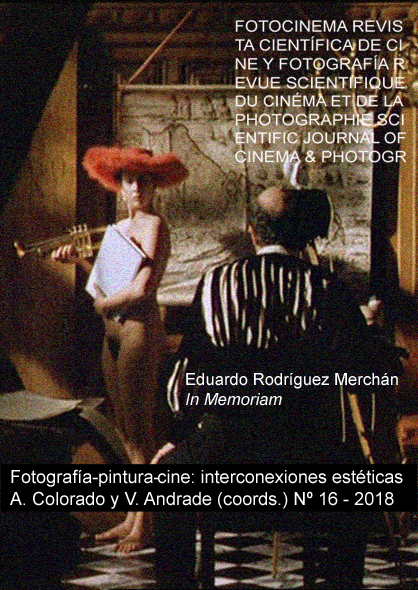Sound of horror: The (im)possible formulation of the monstrous
DOI:
https://doi.org/10.24310/Fotocinema.2018.v0i16.4098Keywords:
Spanish cinema, horror cinema, science fiction, Nieves CondeAbstract
The present essay tries to address the unique formulation of certain thematic features and expressive resources characteristics of the horror films that the film Sound of Horror (1965), directed by José Antonio Nieves Conde, carries out. To this end, we will chose the textual analysis and discourse as methodological tool, since it will allow us to focus on the particularities of the film. Carried out in a period of his career in which the filmmaker undertakes custom projects to survive financially, the film we will be dealing with is one of the best examples of the solvency of his work as a director and narrator. The elusive physicality of the monstrous threat that puts the lives of the protagonists at risk causes a figurative void that entails the underlining of the formal mechanisms through which the enunciation operates.
Downloads
Metrics
Publication Facts
Reviewer profiles N/A
Author statements
Indexed in
-
—
- Academic society
- N/A
- Publisher
- Universidad de Málaga
References
Aguilar, C. (1997). El sonido del miedo. En J. Pérez Perucha (Ed.). Antología crítica del cine español (pp. 604-606). Madrid: Cátedra / Filmoteca Española.
Carroll, N. (2005). Filosofía del terror o paradojas del corazón. Madrid: Antonio Machado.
García Jiménez, J. (1993). Narrativa audiovisual. Madrid: Cátedra.
Herrero Cecilia, J. (2000). Estética y pragmática del relato fantástico: las estrategias narrativas y la cooperación interpretativa del lector. Cuenca: Ediciones de la Universidad de Castilla-La Mancha.
Higueras Flores, R. (Ed.)(2015). Cine fantástico y de terror español. De los orígenes a la edad de oro (1912-1983). Madrid: T&B.
Lenne, G. (1974). El cine fantástico y sus mitologías. Barcelona: Anagrama.
Ocampo Ramírez, G. I. (2013). De la monstruosidad a la alteridad en la obra de Diane Arbus. Trilogía (8), 19–28.
Prédal, R. (1970). Le cinema fantastique. Paris: Seghers.
Todorov, T. (1980). Introducción a la literatura fantástica. México: Premia.
Downloads
Published
How to Cite
Issue
Section
License
All contents published in Fotocinema Revista científica de cine y fotografía are protected under the Creative Commons Attribution-NonCommercial-ShareAlike 4.0 International (CC BY-NC-SA 4.0) license. All about this license is available in the following link: <http://creativecommons.org/licenses/by-nc-sa/4.0>
Users can copy, use, redistribute, share and exhibit publicly as long as:
- The original source and authorship of the material are cited (Journal, Publisher and URL of the work).
- It is not used for comercial purposes.
- The existence of the license and its especifications are mentioned.
There are two sets of authors’ rights: moral and property rights. Moral rights are perpetual prerogatives, unrenounceable, not-transferable, unalienable, imprescriptible and inembargable. According to authors’ rights legislation, Fotocinema. Revista científica de cine y fotografía recognizes and respects authors moral rights, as well as the ownership of property rights, which will be transferred to University of Malaga in open access. The property rights are referred to the benefits that are gained by the use or the dissemination of works. Fotocinema. Revista científica de cine y fotografía is published in an open access form and it is exclusively licenced by any means for doing or authorising distribution, dissemination, reproduction, , adaptation, translation or arrangement of works.
Authors are responsable for obtaining the necessary permission to use copyrighted images.














13.png)



